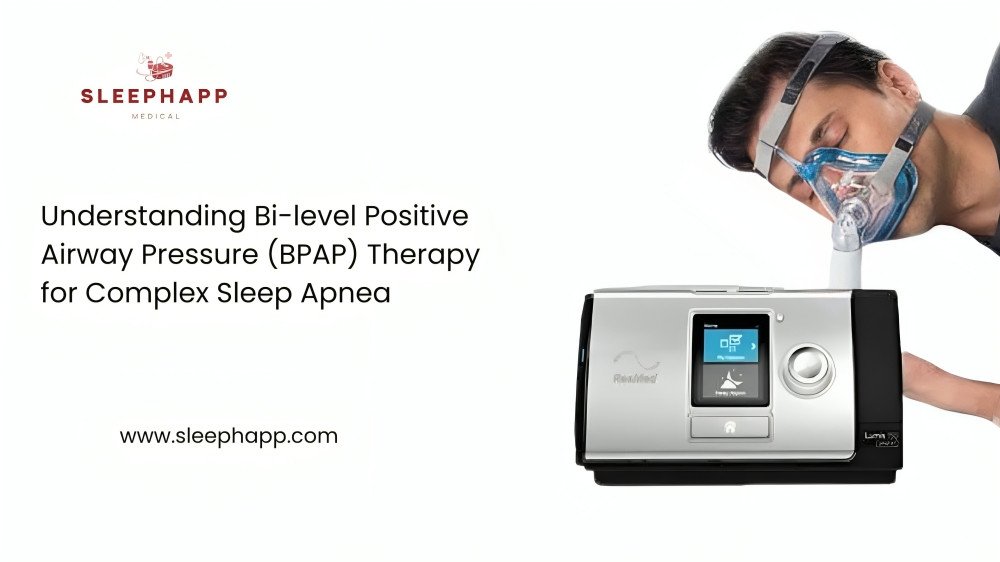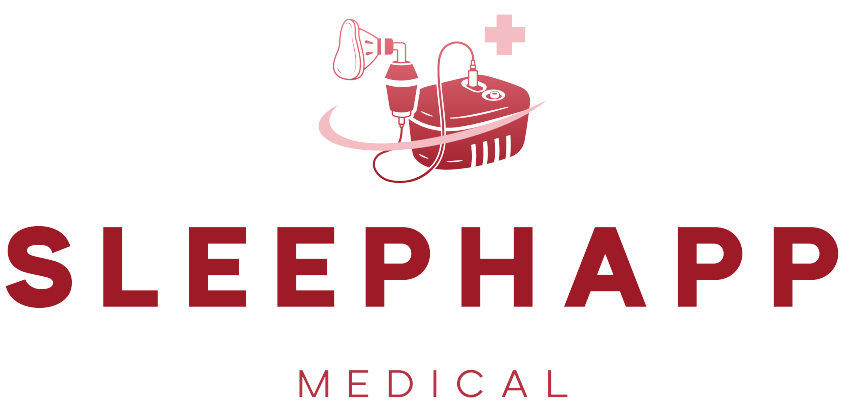Understanding Bi-level Positive Airway Pressure (BPAP) Therapy for Complex Sleep Apnea
Home » Understanding Bi-level Positive Airway Pressure (BPAP) Therapy for Complex Sleep Apnea

Table of Contents
Sleep apnea is a serious sleep disorder where breathing stops and starts. There are three types of sleep apnea: obstructive, central, and complex. Complex sleep apnea is the hardest to treat. It combines features of obstructive and central sleep apnea. Bi-level Positive Airway Pressure (BPAP) therapy is an effective treatment for complex sleep apnea.
What is Bi-level Positive Airway Pressure (BPAP)?
BPAP is a machine that helps with breathing problems during sleep. It provides two levels of air pressure:
- A higher pressure for breathing in (IPAP).
- A lower pressure for breathing out (EPAP).
This dual-pressure system keeps airways open and makes breathing easier. It adapts to changing breathing needs, which is very helpful for people with complex sleep apnea.
Understanding Complex Sleep Apnea
Complex sleep apnea happens when a person has both obstructive sleep apnea (OSA) and central sleep apnea (CSA):
- OSA causes blocked airways during sleep.
- CSA happens when the brain doesn’t signal the body to breathe.
Complex sleep apnea often appears in patients treated with CPAP therapy for OSA. Symptoms include:
- Feeling very tired during the day.
- Sleep is not good.
- Waking up many times at night.
- Headaches in the morning.
- Chest pain or discomfort.
- Hard to focus.
- Mood changes.
To learn more about complex sleep apnea, its causes, and treatments, visit SleepApnea.org.
How BPAP Therapy Works for Complex Sleep Apnea
BPAP therapy delivers pressurized air through a mask during sleep. It adjusts air pressure to match natural breathing patterns:
- For obstructive symptoms, BPAP keeps airways open with higher pressure during inhalation.
- For central symptoms, BPAP stabilizes breathing and prevents pauses.
This flexibility makes BPAP a good solution for complex sleep apnea. To learn more, check out this detailed guide on BPAP.
Benefits of BPAP Therapy
BPAP therapy improves health and life quality for people with complex sleep apnea. Here are its key benefits:
Better Sleep Quality
BPAP ensures steady airflow and reduces breathing problems. This helps you sleep deeply and wake up refreshed.
Fewer Breathing Problems
BPAP reduces the number of times breathing stops during sleep. It stabilizes airflow and keeps sleep patterns consistent.
Improved Oxygen Levels
BPAP prevents oxygen levels from dropping too low. This protects your brain, heart, and overall health.
Comfortable to Use
BPAP machines let you adjust air pressure for natural and comfortable breathing. Many patients find BPAP easier to use than CPAP. Learn more about Benefits of BPAP machines here.
Challenges and Considerations of BPAP Therapy
BPAP therapy is effective but has some challenges. Most can be managed with proper care.
Initial Discomfort
Wearing the mask may feel strange or tight at first. It takes time to adjust.
Side Effects
Some common side effects include:
- Dry mouth: Caused by airflow.
- Nasal congestion: Pressure can lead to stuffiness.
- Skin irritation: Mask may rub against the skin.
Solutions include using a humidifier, adjusting the mask, or switching to a different mask type.
Proper Settings
Air pressure must be set correctly. Regular check-ups help ensure optimal settings.
Emotional Challenges
Using a BPAP machine may cause anxiety or embarrassment. Talking to a doctor or joining a support group can help.
Staying Consistent
Regular use is key for BPAP therapy to work. Education and personalized solutions can improve adherence.
Who is a Candidate for BPAP Therapy?
BPAP therapy is ideal for people with:
- Complex sleep apnea (both obstructive and central).
- Central sleep apnea that doesn’t improve with CPAP.
- Difficulty using CPAP because it feels uncomfortable.
A sleep doctor will decide if BPAP is right for you. Sleep studies help diagnose the condition and guide treatment.
Steps to Begin BPAP Therapy
Starting BPAP therapy involves:
- Diagnosis: Take a sleep study to confirm complex sleep apnea.
- Consultation: Discuss options with a sleep specialist.
- Device Selection: Choose a BPAP machine that fits your needs.
- Customization: Adjust pressure settings and select a comfortable mask.
- Follow-ups: Regular monitoring to check progress and make adjustments.
Conclusion
BPAP therapy helps with complex sleep apnea. It gives air pressure that fits your needs. This treats both obstructive and central apnea. It is a good solution for a hard condition. If you or someone you know has complex sleep apnea, talk to a sleep expert at SleepHapp. They can help you sleep better and stay healthy.
Sources:
- https://www.sleepapnea.org/complex-mixed-sleep-apnea
- https://enticare.com/2024/07/23/bipap-and-cpap-is-bipap-better-than-cpap/
- https://my.clevelandclinic.org/health/treatments/24970-bipap
- https://www.sleepfoundation.org/cpap/what-is-a-bipap-machine
- https://www.verywellhealth.com/what-is-bipap-3015273
